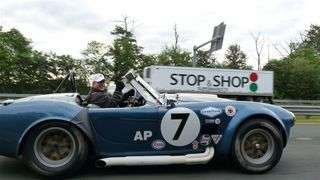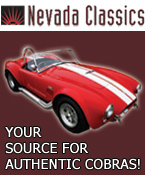I have finally got around to the interview. I will publish w/o edit as that is the right way to approach the subject. I want to thank Peter Bayer for his time and patience.
• Was the original mold pulled directly from or measured from CSX3045 – The original “Splash” mold was.
• What, if anything, was changed in the CCX body –
• Like the original CSX 427 cars, the Series 1 and 2 molds had a drooped right rear fender; this was corrected on the “Plug” used to create the series 3 molds in ’83.
• The front and rear wheel openings are slightly smaller than the originals so that the lower profile tires in production at that time (vs. the taller original tires) looked correct in the wheel wells.
• The rocker panels were extended downward to cover the outer frame rails
• The parking light mounts were given a raised/flat mounting surface so that the lights sat straight.
• How many, if any, experimental cars were made - 2
• Front blinker mounts had a rise which was not original, designer liberty – See above
• How long did the first generation mold survive (years) – less than a year.
• Was the second generation mold just like the first – it was a better quality production mold – The bodies from both the series 1 & 2 molds were 2 piece bodies that were joined under the doors. Series 1 and series 2 bodies produced before 4th Quarter ‘81 were laid up by an outside contractor. All of the bodies from the series 3 molds (put into production in the fall of ’83) were one piece shells that were produced “in house”.
• Was there a Burtis body modification after you sold the company – I don’t think so, however I believe that Burtis bodies produced from mid ’97 onward were manufactured by an outside sub contractor.
• Were bodies # separately from frame. - The bodies and frames of the Series 1 & 2 cars had different chassis & body numbers; the series 3 bodies and frames had matching numbers.
• Was any asymmetry maintained over symmetry – I don’t know what you are referring to.
• Were there experimental frames or bodies which never fell into # system – A few
• Were all Bayer cars torsion bar front suspension – A Coil Over front Suspension and the rear Watts Linkage were introduced when the “fabricated” front suspension components went into production in ‘91
• Were all glass bodies created equal, chopper gun or Hand Layed – All were “Chopper Gun”
• Why sell the company – My partner, Monty Gatti had health problems dating back to early 1984 and had become nearly totally inactive by 1994. Because of my prior background and numerous friends still in the corporate world, I had been receiving regular calls from executive recruiters since joining Contemporary on a full time basis in April of ’83. Between ’92 and ’96 we had also received a number of offers to sell the business; by mid ’96, I felt that it was the right time to sell and accepted an interesting opportunity outside of the “Kit Car” industry.
• Who was your toughest competitor – I always felt (and still do) that of the original Cobra Replica manufacturers dating back to the late ‘70’s – early ‘80’s; when we founded Contemporary, ERA was the only other manufacturer that was producing a quality product that not only looked like an original Cobra, but also was capable of performing like one!
• How did CCX pricing compare to you toughest competitor – CCMCC offered the car in 3 different packages configurations, each of which represented a substantial savings over buying the contents of the package piece by piece; an assembled suspension option could be added to any of the packages. A customer could also purchase the car in “bits and pieces”. ERA only offered 1 package which was somewhere in-between our Deluxe Package when combined with the Assembled Suspension Package.
• What, if anything, would you have done different hindsight being 20/20 – Very difficult to say because so many of the ingredients/principles of a successful business differ so greatly today from what they were at that time.
• What was the toughest challenge as a Cobra MFG – Searching out local vendors who were capable of producing exact reproductions of accessories such as windshield frames and glass, bumpers, side pipes, Alum Side Vents, Dash Panels…etc. most of which were no longer readily available and then making the financial commitment required to develop the tooling necessary to produce these items.
I was firmly convinced that unless the trim and accessory items required to complete the car were readily available it would be impossible for customers to complete their cars and for us to build a meaningful business (as owners of Arntz Replicas, our only other significant competitor at the time, were finding out). If we were unable to supply the required accessory items at the time that purchasers took delivery of their “Kits”, we would be just like most of the other “Flim Flam” artists in the Kit Car business at the time who were just living off of customer deposits. In order to justify the investment required to produce these items, we decided to produce all items exact to original CSX specifications, thus they would also be suitable for use as replacements on original CSX cars. By the early ‘80’s, we were the largest domestic manufacturer of these items and the principal supplier to CSX parts re-sellers and restoration facilities such as Cobra Restorers, Aluminum Restorations, McClusky Ltd…etc. who in turn also sold our parts to competitive Replica manufacturers. This commitment made CCMCC totally self sufficient (we produced our own bodies and frames as well as the other specialized parts and accessories that were required to assemble the finished product) and, equally important, in conjunction with a rapidly evolving nationwide distributor network we were able to provide local assistance to customers during the assembly process. These factors combined to set us far above all of the other Cobra Replica manufacturers at the time.
• Did CS ever try to sue CCM – We were approached by one of Shelby’s representatives via phone in the late ‘80’s who was interested in setting up a Shelby licensing agreement with us. I requested that he put the rationale behind his proposal as well as the proposal itself in writing, submit it to us and I would review it with our attorney and get back to him – needless to say I never received a proposal from him and never heard anything further from him or any of Shelby’s other “henchmen”.
• What happened to Contemporary's Body molds and frame jigs – Factory Five bought all the molds, jigs, fixture,,, etc. when Burtis went “down the tubes”.
• Do you know what happened to frame tooling – See above
• Why was the roll bar built behind the barrier that separates the cockpit from the boot, instead of in front of it, as with the original? – The shape of the rear frame rail “kicks” dictated the shape and location of the rear bulkhead, hence the location of the Roll Bar.
• How come there was never an access panel built into the rear bulkhead to make it easy to service the rear brake calipers on cars with Jag Rears – We felt that access panels would have detracted from the structural integrity of the bulkhead.
• What problems did you encounter with the Jaguar rear end – Many people don’t realize that the Jag center sections are Dana 44 series diffs., like those used in the original Cobras. About the only necessary upgrade were the forged diff. stub axles offered by Concours West for Mega Horsepower cars.
• Did Bayer cars ever come from the factory with removable transmission crossmember – All frames produced from ’89 onward could be ordered with either a solid or a removable Trans. cross member.
• Is there a list of CCX suppliers in existence: Carpeting, seats, door panels, brakes, wheels, 6 pin hubs, etc... The paper files that I was able to salvage when Burtis moved out of CCMCC’s Mamaroneck facility were destroyed in a flood that ravaged our current building a little over 2 years ago, however, since I did most of the ordering, I do remember who most of the suppliers were.
• Did you buy your 289 molds from "Auto Speed Motor Sports" – Only the outer body “Shell” came from Autospeed. We designed and produced the molds for the doors, hood and trunk lid as well as those for all of the inner panels/liners.
• Was there a reason 427 side pipes were lower on the body – As previously mentioned, the rocker panels were dropped slightly to cover the outer frame rails, thus the side pipes were dropped slightly so that the proportions would look correct.
• Were the Jaguar components new or refurbished – The 6 cyl. Jag “E” Type went out of production in ‘72, thus the “E” Jag suspension components were refurbished. We found a source for new “E” Steering Racks in ‘83/’84, thus most of the Steering Racks included with the “factory” Assembled Suspension Option from that time forward were new Racks. Because the front end components were becoming increasingly scarce, in 1991, we developed a fabricated “Clone” front end (which utilized the “Jag” mounting points and duplicated the Jag geometry). These components were also used for the “Coil Over” front ends.
• Was the Contemporary name ever trademarked – I believe that It was registered, I can’t recall if it was trademarked.
• What was your best memory as owner of Contemporary – Foremost are the people; the friendships with customers, distributors, vendors and employees that developed over the 18 year period (1978 -1996). Others include results attained in:
• The various “Run N Gun” events. I did not believe in competing in these events at a “Factory” level because I felt that prospective purchasers would/could relate best to the results achieved by “Customer Cars” vs. the “purpose built” factory cars brought by most of our competitors.
• The “Run Off” against Shelby’s first “Continuation Car” in August of ’93 that was featured in the 11/93 issue of Petersons Kit Car – Of the 7 Cars tested the 10 year old 428 Cobra Jet powered Contemporary Customer Car used in the test (with torsion bar front end and without the benefit of the rear “Watts Linkage system and with nearly 25,000 miles on the odometer) was the only car that equaled or bettered the results/performance of Shelby’s Continuation Car (fitted with a “Competition Prepared” 427 engine) in virtually every test category.
Once again thank you Peter, very cool information...............

Happy Motoring....



